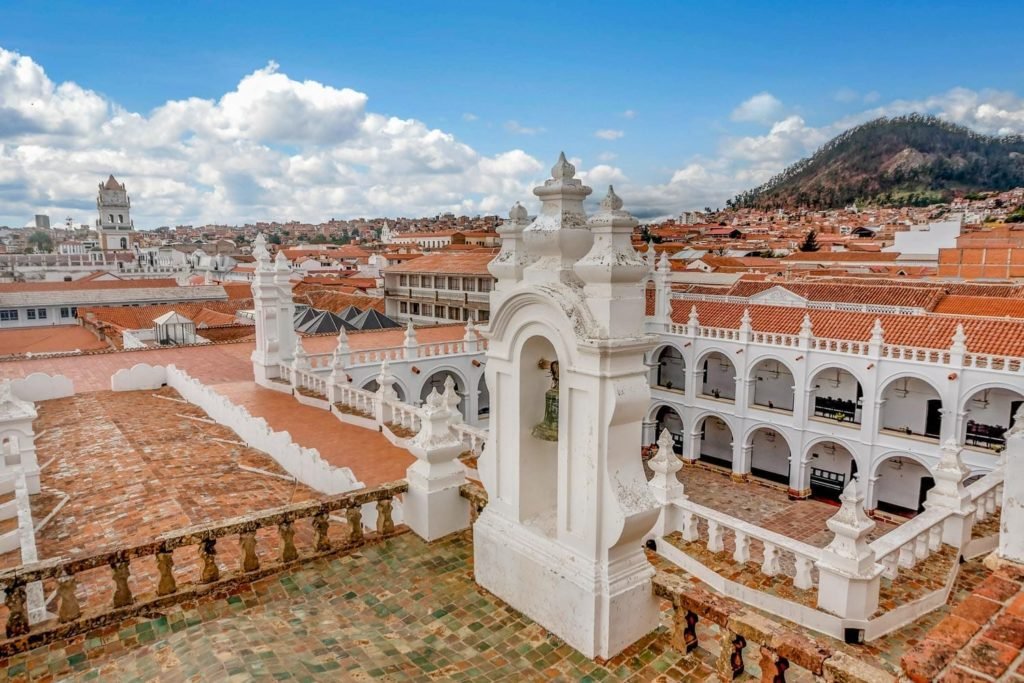Page Menu
Smile. You’ve LANDED in Bolivia.
Bolivia is the truest South American country— an estimated 55% of its population claims indigenous lineage. This proud cultural heritage extends back thousands of years, with Bolivian territory once serving as home to great civilizations such as the Tiwanaku and Tawantinsuyu. Today, Bolivia boasts some of the finest archeological sites and museums on the continent. Here, visitors can explore mountaintop fortresses, admire pre-Inca pyramids, and discover lakeside temples.
CAPITAL SUCRE
LANGUAGE SPANISH
CURRENCY BOLIVIANO
READ THE FAT MAN FROM LA PAZ
SIP & TASTE SALTEÑAS & COCA TEA
EXPERIENCE TITICACA & UYUNI
Start your journey today
Speak with one of our travel designers and let us create a tailored itinerary for you.
Destinations
Where to go in Bolivia

La Paz
The world’s highest capital city, La Paz is the beating heart of Bolivia. Here, towering Illimani looms in the south while snow-covered peaks punctuate its northern corner. The commercial center of South America’s most indigenous nation, La Paz is a bustling metropolis boasting an eclectic urban culture.
Read More

Uyuni Salt Flats
Distant and remote, the Uyuni Salt Flats are one of Bolivia’s most popular attractions. An expansive desert, the area’s chromatic paradoxes draw photographers from around the world. Here, extreme cold, intense sunlight, and a dry atmosphere give rise to a beauty that is breathtaking and eerie.
Read More

Lake Titicaca
Lake Titicaca South America’s largest lake by volume. Straddling the border between Peru and Bolivia, it’s famed for its stunning waters and floating reed islands. Revered as a sacred site by the Incas, it’s a place where ancient traditions and natural beauty harmonize.
Read More
Luxury accommodations in Bolivia
Whether you’re looking for the bustling markets of the city or a beautiful salt flat getaway in Bolivia, comfort and hospitality are right there to welcome you. Find the perfect hotel to match your travels, no matter if you’re looking for a modern retreat or a boutique hotel.
Albums & Stories
Discover our meticulously curated collection of essential information and sought-after insights, designed to help you envision Bolivia as the ultimate luxury travel destination. Whether you’re looking for refined tips, exclusive packing lists, captivating interviews, or awe-inspiring photographs, our comprehensive compilation encapsulates everything about this remarkable country.
FAQ
What is the best time to visit Bolivia?
Due to its altitude, most regions of Bolivia are cool and windy year-round; think highs in the mid-60s F and lows nearing 40°F. Most visitors travel to Bolivia between June and October, when temperatures are less chilly. Bolivians demark the year in terms of rainy season and dry season, rather than winter and summer. Expect sunshine, even throughout the rainiest months (December to February).
The three most visited locations in Bolivia are La Paz, Lake Titicaca, and the Uyuni Salt Flats. During the wettest months (late December to February) the salt pan is flooded by overflow from the north and access to the salt flats is limited. Still, those months are very popular, drawing travelers who want to experience the mirror effect of shallow water reflecting the sky on the salt. Passengers in off-road vehicles crossing the flooded flats often enjoy the sensation of floating.
What language is spoken in Bolivia?
As per 2009 constitution, Spanish and 36 indigenous languages are official in Bolivia. English is spoken in locations frequented by foreign visitors. LANDED can offer bilingual guide services to ensure you don’t miss a single detail of the rich cultural information shared during your travels.
What should I pack for Bolivia?
When packing for Bolivia, layers are the rule. Even if some of those Uyuni and Yungas photos look warm, temperatures change quickly with cloud cover and sunset. Here are some essentials to help you get started:
- Passport: Lock the original in the hotel safe and keep a copy (say, a photo of the passport’s photo page) with you at all times.
- US cash in small denominations (clean, un-torn bills). These are widely accepted as tips. Local currency can be obtained at hotels and through ATMs.
- ATM and credit cards. ATM’s are available and major credit cards are accepted at most restaurants and hotels. Please confirm your travel dates and destinations with your card issuers before you leave the USA. Visit ATMs in your hotel, or with your guide, during the day (not at night).
- Airline ticket information
- Sun protection (sunblock, sunhat and sunglasses). Even on cloudy days, high altitude exposure can burn skin rapidly.
- Camera and data cards or film, batteries
- Electrical adapters
- Prescription medications
- Insect repellant (higher quality repellants—especially those with DEET—are difficult to find locally)
- Anti-itch antihistamine spray (e.g. Benadryl spray) if headed to the Yungas or Amazon
- Rain jacket (or rain repellent shell)
- Synthetic fleece jacket
- Light, informal clothing for dining and hotel or in cities (it’s amazing how versatile a charcoal grey sweater can be)
- Comfortable walking / hiking shoes (preferably waterproof) with substantial (knobby) tread.
- Reusable water bottles. Bottled or filtered water will be available.
- A small daypack (roughly the size of a child’s school backpack). This should be large enough to carry a jacket, water bottle, incidentals, and camera.
How safe is Bolivia?
Although Bolivia is generally quite safe, common-sense precautions are important. In the larger metro areas, big city rules apply. Bag snatchers and pickpockets target public transportation hubs and tourist areas. As a general rule, you should not be out in the streets alone after dark. Stay in well-lit areas and be aware of your surroundings. Most incidents occur in the street. Keep your travel documents (e.g. passports) in the hotel safe or concealed in a zippered pocket. Leave that flashy wristwatch at home or in the hotel security box. Your guides and the hotel concierge can provide additional guidance.





















